
'Bangladesh Information Center' in Washington DC
Last updated: 5 October 2017 From the section 1971 Muktijuddho
The primary focus of activities in the US was to generate support among the elected officials who had influence over policymaking within the executive and legislative bodies of the government. It was also a time of civil rights movement, especially the anti-Vietnam War movement (1955 - 1975), and emergence of other progressive political trends. A segment of the civil rights and humanitarian American public campaigned vigourously for the recognition of Bangladesh. They undertook 'street actions' of different kinds - demonstrations, creation of the 'tent city' in Lafayette Park in front of the White House to highlight the plight of the refuges caused by the war, protest at the Baltimore shipyard against shipment of arms to Pakistan, and other such adventurous deeds. In addition, native Americans who had professional association with and in East Pakistan, as well as the the more politically astute members of the community, took traditional approach of trying to shape policy and generate material support for the war.
Another person from the Cambridge, Massachusetts milieu of supporters, Anna Braun Taylor - wife of Dr. James O. Taylor who worked in the Cholera Research Laboratory in Dhaka around that time - organised a vigil at Thomas Circle on Massachusetts Avenue, near the Pakistan Embassy with the help of Dr. David Nalin and others to draw attention to the atrocities being committed in Bangladesh which attracted a good deal of press coverage. Soon after that, the group decided (also because the Pakistan Embassy objected to her being there) that a more central and politically significant location would be better, and moved the vigil to the Lafayette Park. Number of Bengalis also started to gather around the vigil and provided various forms of support. Thus, with the expressed intention of lobbying on Capitol Hill, the Bangladesh Information Center was established with initial funding from Boston/Baltimore group of health professionals and their friends.
 Anne Braun Taylor ()
Anne Braun Taylor ()  David Nalin ()
David Nalin ()  Robert Dorfman ()
Robert Dorfman ()  Gustav Papaneck ()
Gustav Papaneck ()
The origin of the centre itself was rooted in the tradition of US political practice: seeking redress from the people and their elected representatives through persuasion. The US’s deep involvement in the affairs of Pakistan was well known: some suspected that West Pakistan’s predatory, colony-like relations to East Pakistan had tacit support of various US administrations, if not due to ill-will towards the Bengalis (though they were often suspected of being very susceptible to communist influence and were distrusted for that!), at least because of the services Pakistan (especially the military and politicians be holden to the military) rendered to the US in its cold war machinations vis-à-vis the former Soviet Union. It was clear that at least part of the war of independence of Bangladesh had to be fought in Washington DC, as in few other world metropolises, while the major battle was fought on the actual battleground.
Dr. Mohsin R Siddique, the first general secretary of the Bangladesh Association of America and one of the founders of the Bangladesh Information Center
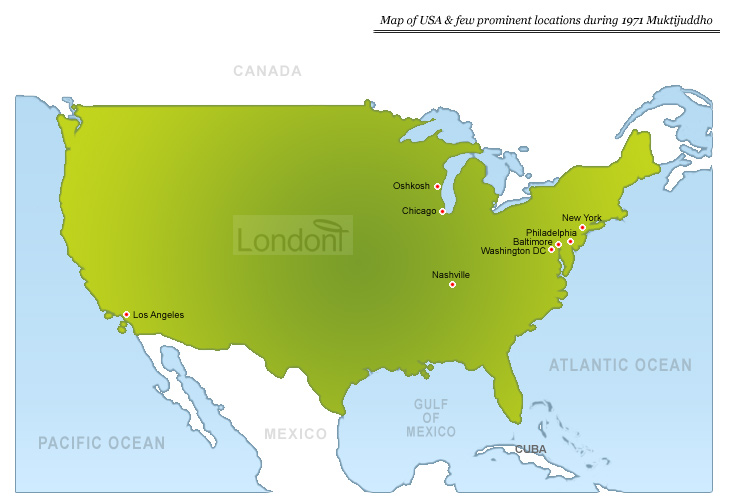
In spring 1971, an office was established on the second floor at 401 Seward Square, SE Washington DC, off Pennsylvania Avenue, and only a few blocks from the Congressional and Senate office buildings. It was a one-bedroom apartment. Anna Braun Taylor offered to be the full-time person-in-charge of the centre. She was unemployed and childless at that time so could dedicate longer hours. The centre soon became a hub of the activities in support of the Bangladesh Liberation War and was frequently visited by probashis and non-Bengali supporters. The center's principal goal was to alter the Nixon administration's strong support of West Pakistan, to which it continued to send arms after the civil war began. Henry Kissinger was especially pro-West Pakistani. Members and supporters of the Bangladesh Information Center worked around the clock in an effort to counter Kissinger's exercise in realpolitik (i.e. politics or principles based on practical rather than moral or ideological considerations). But they failed to sway him, despite the support they received from a vocal minority in the State Department, including a small number of Dhaka-based diplomats who backed the Bengali cause. Anna Braun Taylor's dedication was especially remarkable. She had even travelled to Kolkata and met the members of the Mujibnagar Shorkar to discuss support strategies.
Bangladesh Information Center attracted both new American supporters and other international supporters in the US and Bengalis who were looking for such an entity. It became a clearing-house for information on events going on around the US and in Bangladesh, produced and distributed literature to groups who were organising events around the country. Most important task was to organise groups or individuals (important ones had to be persuaded to come down to DC, often requiring paying for their travel, etc) to see specific congressman or senator, getting on their schedule, contacting their staff, strategy meetings with sympathetic Hill staff to discuss who to lobby, what to say, etc. Appeals went out for financial support for the centre. Some funds did come in, but the American benefactors involved in establishing the centre took care of shortfalls in expenditures (mostly rent, telephone, electricity, postage, etc). My recollection is that Mrs Taylor used the monthly stipend she received form the German government as reparation paid to the Jews who were in German concentration camps towards the expense of the centre. She even visited Calcutta (with her own resources and encouragement from officials at the Indian embassy) to speak directly to Bangladeshi political leaders who were there at the time. Dr Nalin also paid lot of the bills. I have no doubt that the centre had considerable impact on creating American public support in favour of Bangladesh, both among the general public and the policymakers.
Nobel Prize winner's passionate contribution
One probashi who worked within the Bangladesh Information Center would go on to have a grand impact on the new nation in the future. A 30-year-old Muhammad Yunus - the first and only Bengali Nobel Prize winner from Bangladesh - was then working as an assistant professor of economics at Middle Tennessee State University in Murfreesboro, Tennessee since 1969. The young man listened with shock the horrifying ordeal taking place in East Pakistan and the subsequent Declaration of Independence on 26 March 1971 by Ziaur Rahman over the radio in Nashville, Tennessee. He immediately formed the Bangladesh Citizen's Committee with 5 other local Bengalis and together they began to visit local radio and television stations and newspapers to explain the Bangladeshi cause.
 Muhammad Yunus ()
Muhammad Yunus ()
The next day Muhammad Yunus left for Washington DC to attend a pro-Bengali rally and seek out other Bengali patriots. There he met with Enayet Karim, then a second-ranking official in the Pakistani embassy and who later became the foreign secretary of an independent Bangladesh. Enayet Karim and other Bengalis in the embassy were working secretly with the Bengali-American community while they planned to form a separate Bangladesh embassy with the support of the Indian government. On one dramatic occasion Muhammad Yunus and others had to hide in the attic of Enayet Karim's residence for two hours for fear of getting caught by Pakistani ambassador Aga Hilali who dropped by suddenly.
For the first three days after Muhammad Yunus arrived in Washington, he and other activists lived with Enayet Karim. On one of those evenings, the Pakistani ambassador [Aga Hilali] paid an unannounced visit to Enayet Karim's apartment, ostensibly to convey his sympathy for the loss of life in East Pakistan. Horrified at the prospect of his boss' discovering Muhammad Yunus and other activists living with him, Enayet Karim ordered his guest to grab the food they had been eating and flee into a room upstairs, where they had to remain completely still during the entire discussion . That was enough - Muhammad Yunus moved into new living quarters the next day.
Muhammad Yunus also published a newsletter named 'Bangladesh Newsletter' in Nashville to educate the Americans and lobbied at the US Congress to stop military aid to Pakistan. He ran the Bangladesh Information Center with Anna Braun Taylor and other supporters and helped to arrange meeting between visiting Bangladeshi dignitaries and important US policymakers. The Bangladesh Information Center placed newspaper articles on the latest development in Bangladesh and encouraged journalists to visit and report on the ground conditions. It also arranged for assistance to several Bangladeshi sailors who abandoned their ship when they were docked in Baltimore. But the single most important achievement - and raisond d'etre of the centre – was helping with the enactment of the bill that stopped shipment of US arms to Pakistan.
Through the efforts of the Bengalis in Washington, a 'Bangladesh Information Center' was set up near the hill to do the lobbying in the House and the Senate. I took up the responsibility of running the Information Center for the initial period and then went on the road to organise teach-in workshops in university campuses all over the United States, where we also set up Friends of Bangladesh Committees.
During those nine months we drew a very clear picture of the future Bangladesh in our minds, which became sharper and more vivid with each passing day. We wanted to uphold democracy, to establish the majesty of the will of the people which would be expressed in a free and fair election. We wanted to ensure people's right to fashion their lives as they wanted. We wanted people to be free from poverty. We dreamed of a life of happiness and prosperity for all citizens.
We dreamed of a nation which would stand with dignity among all other nations in the world.
In many of these activities the centre received active support of the staff of the Indian embassy. Thus, through its work and help from others, the centre was able to help change the American tilt for Pakistan that Kissinger-Nixon advocated towards Bangladesh.
After the independence of Bangladesh the centre stagnated, in large part as it had achieved it's original objective of stopping US military aid to Pakistan. The vast majority of the supporters had given their utmost and were exhausted by that time, given the intensity of work until the war ended. The centre moved from the Seward Square location to a townhouse not too far, but with the Bangladesh Embassy taking over many of the functions which the centre used to provide, the Bangladesh Information Center did not remain operational for too long.
Meanwhile, inspired by the birth of Bangladesh in 1971, Muhammad Yunus returned to his motherland in 1972 and joined the Economics Department of University of Chittagong after a brief spell in the Planning Commission.
Two powerful brothers gallant effort to spread awareness
Fazlur Rahman Khan - the world renowned American architectural engineer responsible for designing Sears Tower (later renamed Willis Tower) and a Senior Partner of Skidmore, Owings and Merrill (SOM), the largest Architectural firm in America - developed two organisations simultaneously in Chicago, America, in 1971 to aid the Bangladesh Liberation War. The 'Bangladesh Defense League' (BDL) provided support by supplying communication gears to Muktijuddhas in different guerrilla sectors within Bangladesh and mobilizing American public opinion for Bangladesh’s Struggle. It provided much needed technological assistance to different field sectors of the Bangladesh Liberation War, particularly sectors K and Z (led by Major Khaled Mosharraf and Major Ziaur Rahman) fighting the Pakistani military in East Pakistan. Shamsul Bari became the secretary general of the BDL.
Shamsul Bari published the first issue of the Bangladesh Newsletter. I took it over from him and started publishing the newsletter regularly from my Nashville apartment at 500 Paragon Mills Road. My apartment virtually became the communication centre. The phone would never stop ringing whenever I returned from my long campaigning trips. Calls came from all over North America and the UK. All Bengalis in North America wanted to know every detail of the war every day.
Muhammad Yunus on the relentless war efforts of Bengalis in America
The other organisation was the 'Bangladesh Emergency Relief Fund' (BERF) which gave varied assistance to Bengali refugees fleeing across the border into neighbouring India.
Later on, both organisations were merged under the name of 'Bangladesh Foundation' (BF) which operated as a tax exempt public charitable organization. Bangladesh Foundation worked in conjunction with other fellow American-Bengali associations and populace, including the Bangladesh League of America which was working from New York under the leadership of Dr. Khandakar Mohammad Alamgir, and Bangladesh Information Center which was led by Muhammad Yunus and others.
Both Fazlur Rahman Khan and Muhammad Yunus received crucial help from Zillur Rahman Khan, the younger brother of Fazlur Rahman Khan. Zillur Rahman Khan was then the Associate Professor of Dhaka University and Assistant Professor of Political Science at the University of Wisconsin at Oshkosh campus (1971) and was able to provide eye-witness account of the development within Bangladesh.
Dr. Fazlur Rahman Khan had a unique contribution to the freedom struggle of Bangladesh: he helped mobilize American public opinion for that cause. He guided and funded lobbying at the US Congress against Nixon Administration's military hardware assistance to the Pakistan military regime of General Yahya. The whole purpose of the lobbying and persuasion efforts was to enable Dr. Zillur Rahman Khan to share his eye witness accounts of the "selective genocide" of the Pakistani military and their Bengali collaborators with US Congress Representatives and Senators in order to persuade them to oppose Nixon's military aid to General Yahya. Although republican congressmen sought to obstruct Zillur's lobbying efforts a powerful exception was Republican William A. Steiger from the 6th congressional district of Wisconsin. He used his high position in the Republican Party to make sure that Dr. Zillur Khan's "Eye Witness Account of the Pakistani Military Massacre in East Pakistan" would reach the Oval Office. Most notable among the senators Dr. Zillur Rahman Khan received positive response from were Senator Gaylord Nelson, Senator William Proxmire, both representing Wisconsin, and Senator Edward (Ted) Kennedy of Massachusetts.
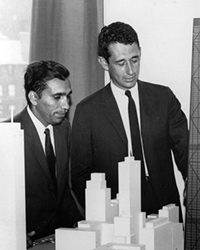 Fazlur Rahman Khan ()
Fazlur Rahman Khan () 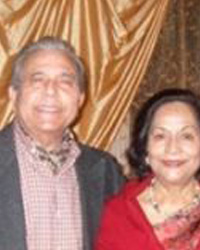 Zillur Rahman Khan ()
Zillur Rahman Khan () 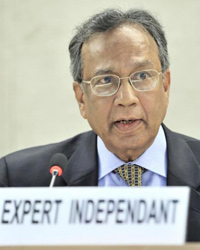 Shamsul Bari ()
Shamsul Bari ()  Khandakar Mohammad Alamgir ()
Khandakar Mohammad Alamgir ()
On his younger brother's suggestion, Fazlur Rahman Khan travelled to Washington DC from Chicago for an emergency meeting with Bengali foreign service officers holding high positions at the Pakistan Embassy in Washington DC with the sole purpose of persuading them to switch allegiance. The meeting was held at the residence of Enayet Karim on 28 April 1971 - eleven days after Mujibnagar Shorkar was officially formed. Fazlur Rahman Khan encouraged defection by offering to cover the full maintenance costs comparable to what what they received as Diplomats of Pakistan for at least a year for any defecting officers. Eventually, these officers quit their positions when they received official order from the Government of Pakistan to report back to Pakistan for "duty".
Upon his return back to Chicago, Fazlur Rahman Khan continued to mobilise support for the Swadhinata Juddho with fulll backing of his partners at SOM.
Motivated by his persuasive arguments for the Freedom Struggle of the Bengalis a number of American professionals joined Fazlur Rahman Khan in his public opinion building campaign. These included Professor Ralph Nicholas, later to become the Dean of Social Sciences and Humanities at the University of Chicago (U.C.), Edward Dimock, Director of South Asian Studies at the same university, Ronald Inden of the Anthropology department of U. C and Chandra Jha, an entrepreneur in the construction field, among many others.
What came as a pleasant surprise when a number of pro-Pakistan professionals working at the time for US universities and corporations changed their stance for the freedom struggle of Bengalis. It showed the effectiveness of persuasive arguments of Dr. Fazlur R. Khan based on eye witness accounts of the "selective genocide" of Dr. Zillur Khan and a few journalists from the West. In this Hon. Archer K. Blood made a big impact on US State Department personnel, swaying some for the cause of Bangladesh to the chagrin of the Nixon Administration. Particularly Henry Kissinger, who was using General Yahya as a conduit to pave the way for Nixon's historic visit to China, penalized Blood with an unattractive transfer to the Carlyle War college.
Meanwhile, Zillur Rahman Khan lobbied the US Congress in Washington against the military regime of Pakistan. He was aided by Abul Maal Abdul Muhith and Kaffey Khan of Bengali Service of Voice of America, who was sacked by the Nixon Administration for his participation.
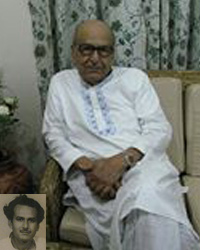 Kaffey Khan ()
Kaffey Khan ()
One high profile American who was deeply moved by Zillur Rahman Khan was Craig Baxter, at the time in charge of Pakistan Desk of the US State Department. Long considered as a pro-Pakistan American diplomat, who spoke fluent Urdu, Craig Baxter argued in favor of the Bengali struggle for independence with his fellow American diplomats after hearing about Zillur Rahman's eye witness accounts.
After the war finished, the Bangladesh Foundation selected Muhammad Yunus as its first Representative in the newly independent Bangladesh. Utilizing resources provided by Bangladesh Foundation, Muhammad Yunus went on to create the Grameen Bank. Meanwhile, Zillur Rahman Khan created a Task Force on Bangladesh in January 1972 with the help of his elder brother, and held a successful Bangladesh Convention at the University of Chicago on 26 March 1972, on the first anniversary of Bangladesh. Zillur Rahman Khan was also elected President of Bangladesh Foundation in 1982, following the passing of the Founder President Fazlur Rahman Khan on 27 March 1982, a day after Bangladesh's 11-year anniversary.
The Bangladesh Foundation continues to provide social services to Bangladesh even today.
